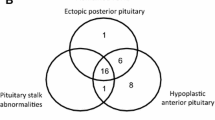Abstract
Inactivating PROP1 gene alterations are responsible for over 50% of familial combined pituitary hormone deficiency cases. Pituitary enlargement followed by regression and subnormal pituitary size has been documented in a number of PROP1 deficient patients. Data derived from PROP1 deficient mice (Ames dwarfs) have revealed some of the underlying cellular mechanisms. Nevertheless, long-term magnetic resonance imaging (MRI) findings in two PROP1 deficient patients suggest the evolution of pituitary pathology as more complex and persistent than previously described. Patient A had enlarged pituitary gland (pituitary height: 9–10 mm), demonstrated by serial MRI carried out from age 5 to 8.5 yr, small pituitary gland (4 mm) at age 10 yr and pituitary enlargement (11 mm) at age 19 yr. Patient B had a pituitary gland of normal size at age 7 yr (5 mm), whereas at age 14.3 and 16.3 yr, an enlarged pituitary gland was disclosed (10 and 11 mm, respectively). Both series of events are suggestive of a persistent pathophysiological mechanism in the pituitary gland of patients with PROP1 gene defects. Therefore, long-term pituitary follow-up by MRI in such patients may be necessary even in the case of a small or normal pituitary gland. It must be noted that current data from the Ames dwarf mouse cannot fully explain the observed pituitary size fluctuation.
Similar content being viewed by others
References
Sornson MW, Wu W, Dasen JS, et al. Pituitary lineage determination by the Prophet of Pit-1 homeodomain factor defective in Ames dwarfism. Nature 1996, 384: 327–33.
Wu W, Cogan JD, Pfaffle RW, et al. Mutations in PROP1 cause familial combined pituitary hormone deficiency. Nat Genet 1998, 18: 147–9.
Scully KM, Rosenfeld MG. Pituitary development: regulatory codes in mammalian organogenesis. Science 2002, 295: 2231–5.
Cohen LE, Radovick S. Molecular basis of combined pituitary hormone deficiencies. Endocr Rev 2002, 23: 431–42.
Parks JS, Brown MR, Hurley DL, Phelps CJ, Wajnrajch MP. Heritable disorders of pituitary development. J Clin Endocrinol Metab 1999, 84: 4362–70.
Mendonca BB, Osorio MG, Latronico AC, Estefan V, Lo LS, Arnhold IJ. Longitudinal hormonal and pituitary imaging changes in two females with combined pituitary hormone deficiency due to deletion of A301, G302 in the PROP1 gene. J Clin Endocrinol Metab 1999, 84: 942–5.
Fofanova O, Takamura N, Kinoshita E, et al. MR imaging of the pituitary gland in children andyoung adults with congenital combined pituitary hormone deficiency associated with PROP1 mutations. AJR Am J Roentgenol 2000, 174: 555–9.
Riepe FG, Partsch CJ, Blankenstein O, Monig H, Pfaffle RW, Sippell WG. Longitudinal imaging reveals pituitary enlargement preceding hypoplasia in two brothers with combined pituitary hormone deficiency attributable to PROP1 mutation. J Clin Endocrinol Metab 2001, 86: 4353–7.
Voutetakis A, Argyropoulou MI, Sertedaki A, et al. Pituitary MR imaging in 15 patients with PROP1 gene mutations: pituitary enlargement may originate from the intermediate lobe. J Clin Endocrinol Metab 2004, 89: 2200–6.
Sertedaki A, Voutetakis A, Argyropoulou M, et al. Pituitary enlargement in patients with PROP1 gene mutations originate from the intermediate lobe. Evidence from long term pituitary MR Imaging in 18 patients (European Society for Paediatric Endocrinology, 43rd Annual Meeting, Basel 2004). Horm Res 2004, 62 (Suppl 2): 21.
Argyropoulou M, Perignon F, Brunelle F, Brauner R, Rappaport R. Height of normal pituitary gland as a function of age evaluated by magnetic resonance imaging in children. Pediatr Radiol 1991, 21: 247–9.
Fluck C, Deladoey J, Rutishauser K, et al. Phenotypic variability in familial combined pituitary hormone deficiency caused by a PROP1 gene mutation resulting in the substitution of Arg→Cys at codon 120 (R120C). J Clin Endocrinol Metab 1998, 83: 3727–34.
Arroyo A, Pernasetti F, Vasilyev VV, Amato P, Yen SS, Mellon PL. A unique case of combined pituitary hormone deficiency caused by a PROP1 gene mutation (R120C) associated with normal height and absent puberty. Clin Endocrinol (Oxf) 2002, 57: 283–91.
BottnerA, Keller E, Kratzsch J, et al. PROP1 mutations cause progressive deterioration of anterior pituitary function including adrenal insufficiency: a longitudinal analysis. J Clin Endocrinol Metab 2004, 89: 5256–65.
Raetzman LT, Ward R, Camper SA. Lhx4 and PROP1 are required for cell survival and expansion of the pituitary primordia. Development 2002, 129: 4229–39.
Ward RD, Raetzman LT, Suh H, Stone BM, Nasonkin IO, Camper SA. Role of PROP1 in pituitary gland growth. Mol Endocrinol 2005, 19: 698–710.
Dasen JS, Barbera JP, Herman TS, et al. Temporal regulation of a paired-like homeodomain repressor/TLE corepressor complex and a related activator is required for pituitary organogenesis. Genes Dev 2001, 15: 3193–207.
Parks JS, Tenore A, Bongiovanni AM, Kirkland RT. Familial hypopituitarism with large sella turcica. N Engl J Med 1978, 298: 698–702.
Turton JP, Mehta A, Raza J, et al. Mutations within the transcription factor PROP1 are rare in a cohort of patients with sporadic combined pituitary hormone deficiency (CPHD). Clin Endocrinol (Oxf) 2005, 63: 10–8.
Parks JS, Baumbach L, Sanchez JC, Stanley CA, Gianella-Neto D. Natural history and molecular mechanisms of hypopituitarism with large sella turcica. Proccedings of the 80th Annual Meeting of the Endocrine Society. 1998, P470 (abstract).
Author information
Authors and Affiliations
Corresponding author
Rights and permissions
About this article
Cite this article
Voutetakis, A., Sertedaki, A., Livadas, S. et al. Pituitary size fluctuation in long-term MR studies of PROP1 deficient patients: A persistent pathophysiological mechanism?. J Endocrinol Invest 29, 462–466 (2006). https://doi.org/10.1007/BF03344131
Accepted:
Published:
Issue Date:
DOI: https://doi.org/10.1007/BF03344131




